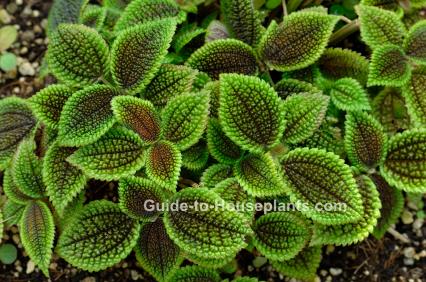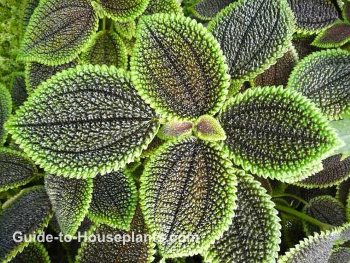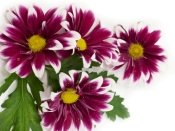Friendship Plant Care
Friendship plant, known botanically as Pilea involucrata 'Moon Valley' has quilted leaves of apple green with deep bronze veins that make it a joy to grow indoors.
In this guide, you'll discover how to keep your houseplant healthy and thriving, with help on how much light it wants year-round, easy ways to boost humidity, and why you want to pinch your plant. (Be sure to root those cuttings and you'll enjoy an ongoing collection of friendship plants!)

Get to Know Friendship Plant
Pilea is a genus of 100s of species, and this is one of the few grown as an indoor plant. One of the most popular cultivars is 'Moon Valley', shown here. It's sometimes sold as Pilea mollis.
'Moon Valley' has a more upright habit than the species, which is a trailing plant. Its toothed, deeply textured leaves feature dark-red undersides.
Does it bloom? Maybe. Clusters of tiny, pink-green flowers may appear in spring, but they are insignificant compared to the showy foliage.
Pilea involucrata has origins in Central and northern South America, where it thrives in a tropical climate. If you can match its native environment, you'll keep it healthy.
Friendship plant likes moist potting medium, warm temperatures, and high humidity. Give this tropical houseplant what it wants and it'll reward you with beautiful foliage.
How big does it get? You can expect friendship plant to reach a height of 6 to 12 in (15 to 30 cm).
Wondering when to repot? Spring is the ideal time, when this plant is beginning its most vigorous time of growth. Don't over-pot -- use a container with drainage holes that's 1- to 2-inches (2.5 to 5 cm) larger than the old one. Why? Plants won't grow much until their roots fill the pot. Besides, a pot that's too big will hold too much water, which may lead to root rot.
Friendship Plant Problems, Solutions and Answers
Pinch your plant. Friendship plant is a bushy, fast-grower with ovate leaves that grow in opposite pairs. Pinch off growing tips, if you want, to keep the plant compact. Those cuttings will root easily, so don't toss them out. Share them with friends or pot them up for more plants.
Dropped leaves can be caused by either dry or soggy soil. However, you can expect the lower leaves to fall off as plants get older, making them look leggy and unattractive. That's another good reason to propagate stem cuttings for more plants -- you may want to replace your plant after a few years.
Brown leaf tips are likely caused by dry air. Raise the humidity for this tropical native if the relative humidity is low indoors. See "Humidity" tips below.
Wilted plants may be suffering from root rot. Friendship plant needs steady moisture, but soggy soil will lead to this problem, which often kills Pilea involucrata.
Is Pilea involucrata poisonous? No, according to ASPCA. It's non-toxic and safe inside a home with cats, dogs and kids.
Something bugging your houseplant? Watch for aphids that are attracted to soft, new growth, which Pileas have in abundance. You'll likely find them clustered at the growing tips of the plant. Cut off any badly damaged leaves. Isolate any infested houseplant right away and treat it with insecticidal soap.

Friendship Plant Care Tips
Light: Moderate to bright light. Place your plant near a window, but away from direct sunlight, which can scorch its leaves. Give Pilea involucrata a quarter turn every few days to expose all sides to sunlight. It thrives under grow lights. Place it 6 to 12 inches (15 to 30 cm) below fluorescent lights for 14 hours a day.
Water: Use a pot with drainage holes and water thoroughly. Allow water to drain, then empty drainage tray. Allow the potting medium to dry out a bit between waterings; friendship plant won't tolerate soggy soil and may get root rot. Keep it slightly drier in winter, when growth is slower.
Humidity: High humidity is a must. It's a good idea to use a humidity monitor near your plant, rather than guess. Indoor air can become extremely dry, especially during the winter months, without our noticing it. If relative humidity drops below 50%, place pot on a tray of wet pebbles or use a cool-mist room humidifier. Pilea involucrata makes an excellent terrarium plant.
Temperature: Average to warm room temperatures (65-80°F/18-27°C) suit this tropical native. Keep it away from heat/AC vents or drafts from doors and windows. Friendship plant will tolerate a low of 55°F/13°C in winter.
Soil: Peat moss-based mix or African violet potting mix.
Fertilizer: Feed monthly in spring and summer with a balanced (such as 10-10-10 NPK) water-soluble fertilizer at half the recommended amount.
Propagation: Take stem tip cuttings in late spring. Put the stem in moist potting mix, then firm the mix around the stem so that it stands up. Enclose the whole pot in a plastic bag to hold in humidity. Friendship plant cuttings root easily in about a month.


